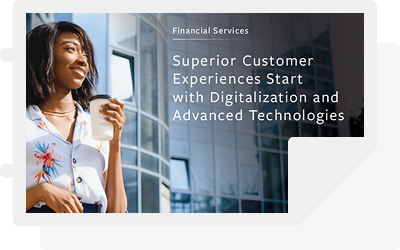Delivering a relevant, timely, and positive customer experience across every touchpoint, during every engagement, has never been more important, or more challenging. For financial services companies, that’s meant pivoting to provide service everywhere a customer is, which now more often than not is mobile-first from cell phones, laptops, and tablets instead of physical branch locations. The trick is to make sure customers are satisfied with their transactions at each of those touchpoints.
One way financial organizations can innovate and respond is by evolving to an Autonomous Digital Enterprise (ADE). An ADE is a future state of business, rooted in emerging technologies like automation, artificial intelligence (AI), and machine learning (ML), that focuses on customer centricity, agility, and driving actionable insights to strategically deliver new value and competitive differentiators.
The Transcendent Customer Experience, the Data-Driven Business, and Automation Everywhere are three tenets of an ADE that are integral to the success of financial organizations as changing customer preferences and ever-growing data volumes and digital channels place new demands on them to keep up. By leveraging the essential handshake between data and automation to drive actionable insights, financial organizations can rapidly adapt and respond to deliver unique customer experiences.
By deploying new technologies, businesses can create new experiences across the entire customer journey—things like mobile apps, self-service tools, and interactive chatbots. Each of those touchpoints involve customers providing their personal and financial data. Automated data analytics can help make sense of all that data, plus data from social media, customer engagement systems, and more so financial companies can deliver proactive, personalized experiences and tailored offers that attract and retain customers.
Elevating the external customer experience should also extend to the internal customers (employees) who handle that data, many of whom are now working remotely. Empowering frontline employees with the latest technology to perform their jobs and supporting them with automated customer-facing tools allows them to focus on more business-critical tasks and provide exceptional customer experiences when human intervention is required.
Intelligent BMC Helix solutions such as BMC Helix Digital Workplace, BMC Helix Chatbot, and BMC Helix Business Workflows can help financial organizations streamline and automate their processes, delight their customers, and move business forward so they can not only survive but thrive as an Autonomous Digital Enterprise. For more information on building a better customer experience, see our white paper, Superior Customer Experiences Start with Digitalization and Advanced Technologies.
Financial Services Superior Customer Experiences Start with Digitalization and Advanced Technologies
These postings are my own and do not necessarily represent BMC's position, strategies, or opinion.
See an error or have a suggestion? Please let us know by emailing blogs@bmc.com.







